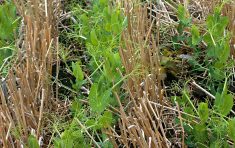Saskatchewan Agriculture wants to hear from farmers who find ergot in their cereals this summer.
The ministry is asking producers to start scouting for the disease a week after crops start flowering and report ergot to their regional offices as soon as it’s detected. It’s all part of a new project designed to help livestock producers.
“We’re doing this to kind of come up with recommendations for producers–giving them guidelines for when it might be safe to cut ergot-infected feed,” says Sean Thompson, regional livestock specialist based out of Saskatchewan Agriculture’s Watrous office. “And the reason this has come up is because ergot is becoming more and more prevalent, it seems.”
Read Also

Dryness poised to threaten Saskatchewan crops
Crops in Saskatchewan are developing in opposite directions, the province’s latest crop report said. Growing conditions in the province vary, with some areas receiving enough rain while other locations are experiencing crop stress due to hot, dry conditions.
Thompson lists North Battleford, Kindersley and Weyburn as ergot hotspots. But he adds the disease can be found anywhere in Saskatchewan, and says it’s already been reported in the Tisdale and Swift Current areas this year.
Ergot produces alkaloids that are toxic to humans and livestock alike. Grain destined for human consumption is screened carefully for ergot.
“But usually those screenings end up in the feed and that’s why it’s troubling for livestock producers,” says Thompson. Livestock that eat ergot-contaminated feed can suffer lameness, loss of body parts due to gangrene, abortions, seizures and death.
From the Manitoba Co-operator: Ergot becomes invisible in manufactured feed
Saskatchewan Agriculture staff will sample infected crops weekly to see if ergot alkaloids accumulate as the summer wears on. The ministry is relying on farmers to report the disease as soon as they notice it.
“If they notice it and don’t let us know until part way through the summer, then that kind of takes away that key time frame that we’re looking for right after infection to (when) seeds are actually filling out,” says Thompson.
Weather has been on ergot’s side recently. Ergot bodies, which produce the spores, need cool, damp weather in the spring to germinate, Thompson says. Cooler weather at the end of June and into July extends the flowering period, which also favours ergot. If July proves cool and cloudy “then chances are there’ll be a lot more infection,” he says.
Agronomic practices, such as minimum tillage, also foster ergot, Thompson adds. When the ergot bodies are buried, they’re less likely to infect the next crop. But with minimum tillage, the ergot bodies remain in crop residue on the surface.
Growing cereals back to back also boosts risk, Thompson says, “because the sclerotia won’t survive usually more than a year.”
But the previous year’s crop isn’t the only potential disease source.
“It can come from the field itself but a lot of the cases of ergot infection come from the grasses in the ditch,” says Thompson. Next to rye and triticale, grasses are most susceptible to ergot, Thompson adds.
“If you’re scouting your ditches and you see ergot in your ditch, chances are you’re probably going to see it in the field, too.”
Contact information for Saskatchewan Agriculture’s regional offices is available online.
















